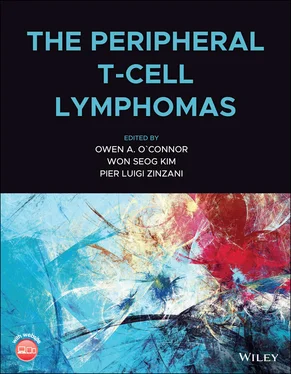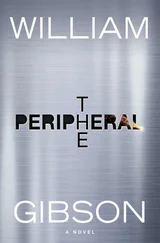Among lymphoid malignancies, dysregulation of the IDH epigenetic pathway has been best characterized in TCL. The detection of recurrent IDH2 mutations in AITL, especially with substitutions at R172 has suggested a therapeutic target in the treatment of this difficult disease [45, 97]. Whole‐exome sequencing of peripheral TCL samples has demonstrated that approximately 30% of patients with AITL have IDH2 mutations, although such mutations occur less frequently in other subtypes of PTCL [35, 50, 98]. Similar to acute myeloid leukemia (AML), R172 is the most prevalent IDH mutation. It is associated with having the highest levels of 2‐HG compared with the other two hotspot mutations, IDH1R132 and IDH2R140 [97], and should be considered an important biomarker for the selection of patients to receive IDH inhibitors, potentially regardless of tumor histology. Interestingly, according to results published in the past few years, all cells harboring IDH2 mutations are PD‐1+ and are associated with downregulation of Th1 cell‐like differentiation genes (such as STAT1 and IFNG) [35, 50, 98]. Furthermore, an analysis of gene expression signatures demonstrated increased methylation of the promoters that regulate T‐cell receptor signaling and T‐cell differentiation in IDH2R172K cell lines, illustrating a potential mechanism of lymphomagenesis [50]. No data are currently available from preclinical studies testing IDH inhibitors specifically in models of IDH‐mutant lymphomas, such as AITL or chronic lymphocytic leukemia (CLL).
Both the IDH2 inhibitor enasidenib and, subsequently, the IDH1 inhibitor ivosidenib have been approved in the past two years for patients with relapsed and/or refractory AML who carry mutations in IDH2 or IDH1, respectively [99, 100]. Enasidenib (AG‐221), a novel IDH2 inhibitor, has been found to be effective in patients with R/R acute myeloid leukemia who have IDH2 R140 and R172 mutations, leading to its approval in this population [99]. Currently, no results are available from trials of IDH inhibitors in lymphoma. However, clinical trials investigating inhibitors of IDH2 (enasidenib), IDH1 (ivosidenib) and both IDH1 and IDH2 (vorasidenib) in patients with advanced‐stage hematological malignancies are currently underway. Of particular note, enasidenib is currently being investigated in a phase I/II trial specifically for patients with IDH2 ‐mutated AITL (NCT02273739).
Another novel epigenetic target is the EZH2. EZH2 is the enzymatic subunit of polycomb repressor complex 2 along with EED and SUZ12 involved with histone acetylation and subsequent epigenetic gene suppression [101]. EZH2 is the enzymatic subunit that catalyzes the methylation of Lys27 of histone H3 (H3K27) with as many as three methyl groups. EZH2 has an essential role in germinal centers B (GCBs) that give rise to follicular lymphoma and DLBCL, as documented in mouse models in which deletion of this gene completely abrogated the formation of germinal centers. This effect is mediated by the EZH2‐mediated silencing of genes encoding cell cycle checkpoint proteins and those involved in plasma cell differentiation [102–104]. Mutations in EZH2 are highly prevalent in patients with B cell lymphomas and occur specifically in GCB‐DLBCLs and follicular lymphomas, with an incidence of approximately 15–20% in both tumor types [105, 106]. The vast majority of these genetic lesions involve point mutations resulting in substitution of tyrosine 641 (Y641; either Y641F, Y641N, Y641S, or Y641H) within the histone methyl‐transferase domain of EZH2. These alterations lead to a gain‐of‐function effect whereby the mutant form of this protein enables more efficient trimethylation of H3K27 [107]. EZH2 inhibitors first entered clinical trials in 2013. Results from these initial trials have since been reported for tazemetostat, valemetostat, and GSK2816126, and generally show encouraging preliminary results for B cell lymphomas [108–110].
In contrast to B‐cell lymphomas, EZH2 acts as a tumor suppressor in T‐cell malignancies, which manifest loss‐of‐function mutations of EZH2 and genes encoding other components of PRC2 [111]. In particular, genes encoding components of PRC2 have an especially high rate of deletions or sequence mutations in early T‐cell precursor acute lymphoblastic leukemia (ALL) [112]. Homozygous inactivation of EZH2 in mouse models of leukemia was found to accelerate the progression of early T‐cell precursor ALL, in part through activation of the STAT3 pathway [113]. EZH2 has been found to be expressed in many types of PTCL, including ALCL (ALK positive and negative as well as primary cutaneous subtypes), PTCL‐NOS, AITL, NKTL, and ATLL by immunohistochemistry [53, 114]. EZH2 has been found to be necessary for Tax‐dependent cell growth and immortalization [75]. Lymphocyte activation by anti‐CD3/CD28 stimulation or polymethacrylate/ionomycin increases EZH2 expression. In ATLL, NF‐κB activation plays a critical role in the chronic expression of EZH2. Targeting this pathway with EZH2 inhibitors may reverse the reprogramming and specifically eliminate cancerous cells while sparing normal CD4+ T cells. Early‐phase clinical trials are ongoing to test this hypothesis [53, 115, 116].
Dual inhibition of EZH1 and EZH2 might lead to greater suppression of H3K27 trimethylation and provide higher levels of anti‐lymphoma activity than inhibition of EZH2 alone [117]. This discovery has led to the development of valemetostat, which has indeed shown good levels of activity across a range of B‐ and T‐cell NHL subtypes (53% overall response rate and 86% clinical benefit rate in a phase I trial involving 15 patients). Of particular note, an 80% overall response rate was reported in patients with TCL [110]. Given the encouraging clinical activity and tolerability of this class of drugs, tazemetostat is being investigated in various patient populations and drug combinations such as with chemotherapy (NCT02889523) or immunotherapy (NCT02220842).
Bromodomains are protein motifs that recognize and bind to acetylated lysine moieties located on histone tails. BETs consist of two amino‐terminal tandem bromodomains and an extra‐terminal (non‐bromodomain) region. The BET family includes BRD2, BRD3 and BRD4 and bromodomain testis‐specific protein [118]. Upon binding to acetylated lysine groups, BETs induce gene expression either directly by recruiting transcription factors to DNA and initiating transcription or indirectly by interacting with gene super‐enhancers (non‐coding regions of DNA that bind to transcription factors and activate nearby target genes controlling cellular identity). Thus, BETs contribute to the development and progression of malignancies by both activating and potentiating the expression of key oncogenes [119].
Although BET mutations or translocations are rare, BETs can be overexpressed [120]. Consequently, BET inhibition has been shown to be effective in preclinical studies across multiple types of cancers, including breast, neuroendocrine, ovarian, and hematological malignancies, as well as in rhabdomyosarcoma and glioma [121–125]. BET inhibitors appear to be active in CTCL, EBV‐associated lymphoproliferative disease and primary effusion lymphoma and have been shown to decrease the rate of tumor growth and disease progression in mouse xenograft models [126–128]. Several phase I trials designed to test BET inhibitors, including molibresib, CC‐90010, and INCB054329, are currently ongoing for patients with various advanced‐stage malignancies. In December 2018, data from 27 patients with various subtypes of non‐Hodgkin lymphoma treated with molibresib were presented at the American Society of Hematology annual meeting. The overall response rate among the entire cohort was 18.5%, with one patient with DLBCL having a sustained complete remission after receiving treatment for 54 weeks. Also of note, three of six patients with TCL had a partial response [129]. However, at the time of writing no further studies with molibresib were planned for lymphoma.
Читать дальше












